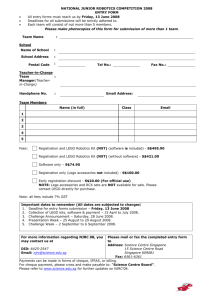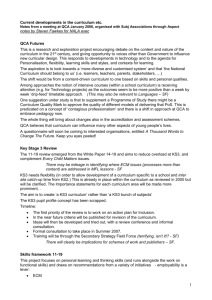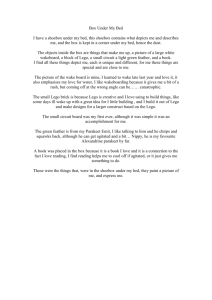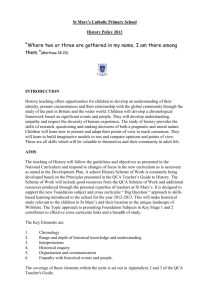samples of teachers guide
advertisement
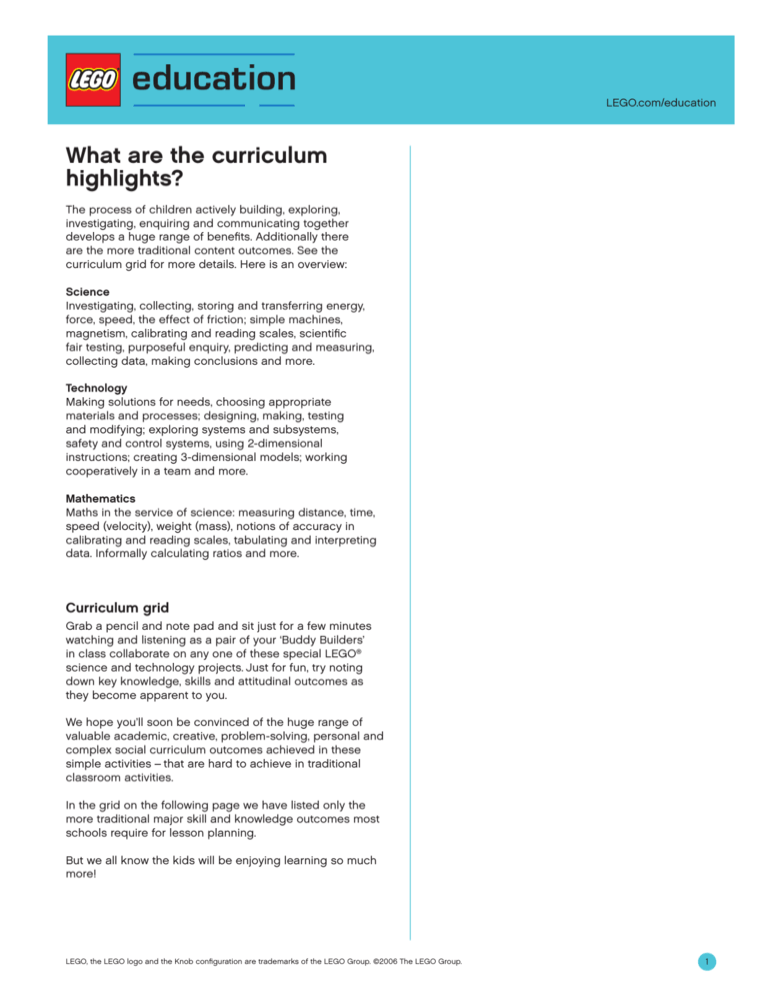
LEGO.com/education What are the curriculum highlights? The process of children actively building, exploring, investigating, enquiring and communicating together develops a huge range of benefits. Additionally there are the more traditional content outcomes. See the curriculum grid for more details. Here is an overview: Science Investigating, collecting, storing and transferring energy, force, speed, the effect of friction; simple machines, magnetism, calibrating and reading scales, scientific fair testing, purposeful enquiry, predicting and measuring, collecting data, making conclusions and more. Technology Making solutions for needs, choosing appropriate materials and processes; designing, making, testing and modifying; exploring systems and subsystems, safety and control systems, using 2-dimensional instructions; creating 3-dimensional models; working cooperatively in a team and more. Mathematics Maths in the service of science: measuring distance, time, speed (velocity), weight (mass), notions of accuracy in calibrating and reading scales, tabulating and interpreting data. Informally calculating ratios and more. Curriculum grid Grab a pencil and note pad and sit just for a few minutes watching and listening as a pair of your ‘Buddy Builders’ in class collaborate on any one of these special LEGO® science and technology projects. Just for fun, try noting down key knowledge, skills and attitudinal outcomes as they become apparent to you. We hope you’ll soon be convinced of the huge range of valuable academic, creative, problem-solving, personal and complex social curriculum outcomes achieved in these simple activities – that are hard to achieve in traditional classroom activities. In the grid on the following page we have listed only the more traditional major skill and knowledge outcomes most schools require for lesson planning. But we all know the kids will be enjoying learning so much more! LEGO, the LEGO logo and the Knob configuration are trademarks of the LEGO Group. ©2006 The LEGO Group. 1 What are the curriculum highlights? LEGO.com/education Key Science Curriculum Key D & T Curriculum Scientific enquiry including predicting, estimating, observing, measuring, conducting careful investigations, recording plus: Working with materials and components, incorporating mechanisms into structures, systems and subsystems, evaluating products plus: Sweeper • Gearing up for speed • Balanced and unbalanced forces • Pulley drives for safety Big Game Fishing • Reducing speed and increasing force using string and pulleys (block and tackle) • Ratchet and pawl safety system • Designing products/ games Freewheeling • Using wheels and axles to move loads • Inclined planes and measuring distances The Hammer • Levers, cams and inclined planes • Exploring friction Forces & Motion • Control and timing of actions • Designing mechanical toys Made to measure Trundle Wheel • Gearing down • Reading and calibrating scales to measure distance Letter Balance • Levers, pulleys and balanced forces • Reading and calibrating scales to measure mass Click-Clock • Gearing up, pendulums and falling weights • Reading and calibrating scales to measure time • Feedback system controlling speed of fall of the weight Windmill • Capturing wind energy to run machines • Storing and transferring energy • Ratchet and pawl as safety and control mechanism Land Yacht • Capturing wind energy for transport • Transforming energy (gearing down) • Flywheel as a speed control mechanism Flywheeler • Storing kinetic/moving energy • Balanced and unbalanced forces Energy Magnetism Magno-Bird • Metals and non metals • Detecting magnetic fields • Properties of materials • Designing products/games Circus Magna • Like poles repel, unlike poles attract • Behaviour of magnets • Automatic counting systems LEGO, the LEGO logo and the Knob configuration are trademarks of the LEGO Group. ©2006 The LEGO Group. 2 LEGO.com/education Links to QCA Schemes of Work There are significant links between the LEGO Education units and the QCA schemes of work. In Design & Technology units for years 5 and 6 there is considerable emphasis on understanding mechanisms. In the QCA D&T Unit 5C: Moving Toys, children learn about controlling movement with a cam mechanism as part of a simple toy. The QCA D&T Unit 6C: Fairground enables children to gain understanding of an important mechanism, using belts and pulleys. Although the focus of the QCA D&T Unit 6D: Controllable Vehicles, is using electricity to drive and control, there is scope for controlling using simple mechanisms. There is also scope for dealing with science concepts. Several LEGO Education units extend the understanding required for the QCA Science Unit 6E: Forces in Action, and two enable the teaching of magnetism as required by the QCA Science Unit 3E: Magnets and Springs. The QCA Science focus Unit 4E: Friction is embedded in several models as is 3C: Characteristics of Materials. LEGO, the LEGO logo and the Knob configuration are trademarks of the LEGO Group. ©2006 The LEGO Group. 3 Links to QCA Schemes of Work LEGO.com/education Sweeper You can use this activity to meet some of the requirements of the QCA Design & Technology Unit 6D: Controllable Vehicles. This activity extends the understanding required for the QCA Science Unit 6E: Forces in Action. Big Game Fishing You can use this activity to meet some of the requirements of the QCA Design & Technology Unit 6C: Fairground. This activity extends the understanding required for the QCA Science Unit 6E: Forces in Action and 3C: Characteristics of Materials and revisits magnetism. Freewheeling You can use this activity to meet the requirements of the QCA Design & Technology Unit 2A: Vehicles. This activity extends the understanding required for the QCA Science Unit 2E: Forces and Movement and 4E: Friction. The Hammer You can use this activity to meet some of the requirements of the QCA Design & Technology Unit 5C: Moving Toys. This activity extends the understanding required for the QCA Science Unit 6E: Forces in Action and 4E: Friction. LEGO, the LEGO logo and the Knob configuration are trademarks of the LEGO Group. ©2006 The LEGO Group. 4 Links to QCA Schemes of Work LEGO.com/education Trundle Wheel This activity develops an understanding of mechanisms similar to that required for QCA Design & Technology Unit 5C: Moving Toys. This activity extends the understanding required for the QCA Science Unit 2E: Forces and Movement and provides an interesting opportunity to carry out a wide range of measurement investigations. Letter Balance This activity develops an understanding of mechanisms similar to that required for QCA Design & Technology Unit 5C: Moving Toys. This activity extends the understanding required for the QCA Science Unit 6E: Forces in Action. It provides a great opportunity to carry out a wide range of measurement investigations. Click-Clock You can use this activity to meet the requirements of the QCA Design & Technology Unit 5C: Moving Toys. This activity extends the understanding required for the QCA Science Unit 6E: Forces in Action. Windmill You can use this activity to meet the requirements of the QCA Design & Technology Unit 5C: Moving Toys. This activity extends the understanding required for the QCA science Unit 6E: Forces in Action. LEGO, the LEGO logo and the Knob configuration are trademarks of the LEGO Group. ©2006 The LEGO Group. 5 Links to QCA Schemes of Work LEGO.com/education Land Yacht You can use this activity to meet some of the requirements of the QCA Design & Technology Unit 6D: Controllable Vehicles. This activity extends the understanding required for the QCA science Unit 6E: Forces in Action, 4E: Friction and 3C: Characteristics of Materials. Flywheeler You can use this activity to meet some of the requirements of the QCA Design & Technology Unit 6D: Controllable Vehicles. This activity extends the understanding required for the QCA Science Unit 2E: Forces and Movement and 4E: Friction. Magno-Bird You can use this activity to meet some of the requirements of the QCA Design & Technology Unit 5C: Moving Toys. This activity extends the understanding required for the QCA Science Unit 3E: Magnets and Springs. Circus Magna You can use this activity to meet the requirements for understanding magnetism in the QCA Science Unit 3E: Magnets and Springs and some of requirements of the QCA Design & Technology Unit 6C: Fairground. LEGO, the LEGO logo and the Knob configuration are trademarks of the LEGO Group. ©2006 The LEGO Group. 6

